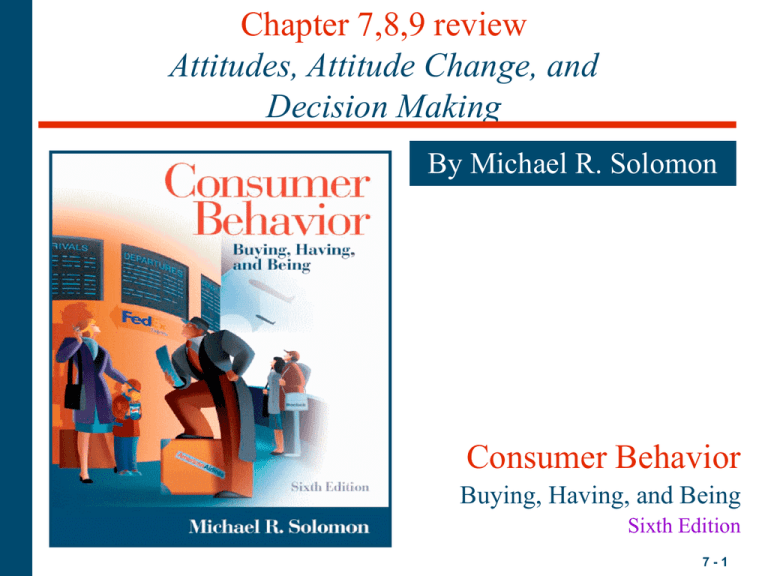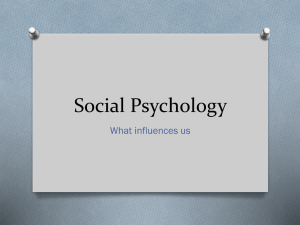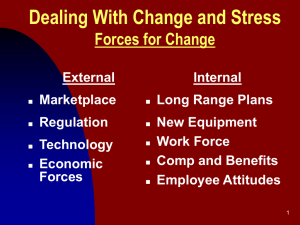Chapter 1 Consumers Rule
advertisement

Chapter 7,8,9 review Attitudes, Attitude Change, and Decision Making By Michael R. Solomon Consumer Behavior Buying, Having, and Being Sixth Edition 7-1 The Power of Attitudes • Attitude: – A lasting, general evaluation of people (including oneself), objects, advertisements, or issues – Anything toward which one has an attitude is called an object (Ao). – Attitudes are lasting because they tend to endure over time. 7-2 The Functions of Attitudes • Functional Theory of Attitudes: – Attitudes exist because they serve some function for the person (i.e., they are determined by a person’s motives) • Katz’s Attitude Functions – – – – Utilitarian function (Drink coke for the taste of it) Value-expressive function (Nike: Just Do It) Ego-defensive function (Right Guard Deodorant) Knowledge function (Advil and Vioxx) 7-3 Addressing Smoking Attitudes • This Norwegian ad addresses young people’s smoking attitudes by arousing strong negative feelings. The ad reads (left panel) “Smokers are more sociable than others.” (Right panel): “While it lasts.” 7-4 The ABC Model of Attitudes • Affect: – The way a consumer feels about an attitude object • Behavior: – Involves the person’s intentions to do something with regard to an attitude object • Cognition: – The beliefs a consumer has about an attitude object • Hierarchy of Effects: – A fixed sequence of steps that occur en route to an attitude 7-5 Three Hierarchies of Effects Figure 7.1 7-6 Attitude Hierarchies • The Standard Learning Hierarchy: – Consumer approaches a product decision as a problem-solving process • The Low-Involvement Hierarchy: – Consumer does not have strong initial preference – Consumer acts on limited knowledge – Consumer forms an evaluation only after product trial • The Experiential Hierarchy: – Consumers act on the basis of their emotional reactions 7-7 Smith and Wollensky • This ad for New York’s famous Smith & Wollensky restaurant emphasizes that marketers and others associated with a product or service are often more involved with it than are their consumers. 7-8 Product Attitudes Don’t Tell the Whole Story • Attitude Toward the Advertisement (Aad): – A predisposition to respond in a favorable or unfavorable manner to a particular advertising stimulus during a particular exposure occasion • Ads Have Feelings Too: – Three emotional dimensions: • Pleasure, arousal, and intimidation – Specific types of feelings that can be generated by an ad • Upbeat feelings: Amused, delighted, playful • Warm feelings: Affectionate, contemplative, hopeful • Negative feelings: Critical, defiant, offended 7-9 Forming Attitudes • Not All Attitudes are Created Equal: – Levels of Commitment to an Attitude: The degree of commitment is related to the level of involvement with an attitude object • Compliance (Pepsi at the exchange) • Identification (Clothing, jewelry, shoes, music) • Internalization (Apple Mac User’s, Newton’s) – The Consistency Principle: • Principle of Cognitive Consistency: Consumers value harmony among their thoughts, feelings or behaviors to be consistent with other experiences 7 - 10 Levels of Attitudinal Commitment • By describing Cadillac as “my company,” the woman in this ad exhibits a high level of attitudinal commitment to her employer. 7 - 11 Attitudinal Commitment • This ad for a magazine illustrates that consumers often distort information so that it fits with what they already believe or think they know. 7 - 12 Balance Theory • Triad: – An attitude structure consisting of three elements • (1) A person and his/her perceptions of • (2) an attitude object, and • (3) some other person or object • Marketing Applications of Balance Theory – Celebrity endorsements 7 - 13 Alternative Routes to Restoring Balance in a Triad Figure 7.2 7 - 14 Changing Attitudes Through Communication • Persuasion: – An active attempt to change attitudes – Basic psychological principles that influence people to change their minds or comply with a request: •Reciprocity •Scarcity •Authority •Consistency •Liking •Consensus 7 - 15 Decisions, Decisions: Tactical Communications Options • Who will be the source of the message? – Man, woman, child, celebrity, athlete? • How should message be constructed? – Emphasize negative consequences? – Direct comparison with competition? – Present a fantasy? • What media will transmit the message? – Print ad, television, door-to-door, Web site? • What are the characteristics of the target market? – Young, old, frustrated, status-oriented? 7 - 16 The Traditional Communications Model Figure 8.1 7 - 17 An Updated Communications Model Figure 8.2 7 - 18 The Source • Source effects: A message will have different effects if communicated by a different source. • Two important source characteristics: – Credibility and Attractiveness • Source credibility: A source’s perceived expertise, objectivity, or trustworthiness. 7 - 19 The Source (cont.) • Building Credibility: Credibility can be enhanced if the source’s qualifications are relevant to the product. • Hype versus Buzz: The Corporate Paradox – Corporate Paradox: The more involved a company appears to be in the dissemination of news about its products, the less credible it becomes. • Buzz: Word of mouth, viewed as authentic • Hype: Corporate propaganda, viewed as inauthentic 7 - 20 Source Attractiveness in Ads • To stimulate demand for milk, an industry trade group tapped a huge range of celebrities to show off their milk mustaches. 7 - 21 Star Power: Celebrities as Communications Sources • Cultural meanings: – Symbolizes important categories such as status, social class, gender, age, and personality type. – Match up hypothesis: The celebrity’s image and that of the product are similar – Q rating (Q stands for quality) considers two factors: • Consumers’ level of familiarity with a name • The number of respondents who indicate that a person, program, or character is a favorite. 7 - 22 Would you buy something from this man? • Who is the target market for Drew? 7 - 23 Sending the Message • Repetition: – Mere Exposure: People tend to like things that are more familiar to them, even if they are not keen on them initially. – Habituation: Consumer no longer pays attention to the stimulus because of boredom or fatigue 7 - 24 Constructing the Argument • One- Versus Two-Sided Arguments: – Supportive argument: Presents only positive arguments – Two-sided message: Presents positive and negative info • Comparative Advertising: – A strategy in which a message compares two or more recognized brands and compares them on the basis of attributes. 7 - 25 Types of Message Appeals • Emotional Versus Rational Appeals: – Choice depends on the nature of the product and the type of relationship that consumers have with it – Recall of ad content tends to be better for “thinking” rather than “feeling” ads • Sexual Appeals: – Sex draws attention to the ad but may be counterproductive unless the product itself is related to sex • Humorous Appeals: – Distraction: Humorous ads inhibit the consumer from counterarguing (thinking of reasons not to agree with the message), increasing the likelihood of message acceptance 7 - 26 Emotional vs. Rational • These ads demonstrate rational versus emotional message appeals. At the time of the initial ad campaign for the new Infiniti automobiles, the ads for rival Lexus (top) emphasized design and engineering, while the ads for Infiniti (bottom) did not even show the car. 7 - 27 Humor Appeals • This ad relies upon humor to communicate the message that skiers and snowboarders should wear helmets. 7 - 28 Personification • Many products are personified by make-believe characters. 7 - 29 The Source vs. The Message: Sell the Steak or the Sizzle? • Elaboration Likelihood Model (ELM): – Assumes that once a customer receives a message, he or she begins to process it. • The Central Route to Persuasion: – The processing route taken under conditions of high involvement – Cognitive Responses • The Peripheral Route to Persuasion – The processing route taken under conditions of low involvement – Peripheral Cues 7 - 30 The ELM Model Figure 8.5 7 - 31 Support for the ELM • The ELM has received a lot of research support • Example: Typical ELM Study – Thought listing – Independent variables: • Message-processing involvement • Argument strength • Source characteristics – Findings: • High involvement subjects had more cognitions • High involvement subjects swayed by powerful arguments • Low involvement subjects influenced by attractive sources 7 - 32 Consumers As Problem Solvers • A consumer purchase is a response to a problem. • Steps in the decision process: – – – – (1) Problem recognition (2) Information search (3) Evaluation of alternatives (4) Product choice • Amount of effort put into a purchase decision differs with each purchase. 7 - 33 Stages in Consumer Decision Making Figure 9.1 7 - 34 CPM The 8 Stages of Consumer Information Processing 7 - 35 Illustrating the Decision-Making Process • This ad by the U.S. Postal Service presents a problem, illustrates the decisionmaking process, and offers a solution. 7 - 36 Types of Consumer Decisions • Extended Problem Solving: – Corresponds to traditional decision-making perspective • Limited Problem Solving: – People use simple decision rules to choose among alternatives • Habitual Decision Making: – Choices made with little to no conscious effort – Automaticity: Characteristic of choices made with minimal effort and without conscious control 7 - 37 A Continuum of Buying Decision Behavior Figure 9.2 7 - 38 Problem Recognition • Problem recognition: – Occurs whenever the consumer sees a significant difference between his or her current state of affairs and some desired or ideal state • Need recognition: The quality of the consumer’s actual state moves downward • Opportunity recognition: The consumer’s ideal state moves upward – Primary demand: Consumers are encouraged to use a product or service regardless of the brand they choose – Secondary demand: Consumers are encouraged to use a specific brand – can only occur if primary demand exists 7 - 39 Information Search • Types of Information Search: – Prepurchase search: Consumer recognizes a need and then searches the marketplace for specific information – Ongoing search: Browsing for fun or staying upto-date on what’s happening in the market • Internal Versus External Search: – Internal search: Scanning our own memory banks for information about product alternatives – External search: Obtaining product information from advertisements, friends, or by observing others 7 - 40 Do Consumers Always Search Rationally? • Consumers don’t necessarily engage in a rational search process • Brand Switching: – Changing brands even if the current brand satisfies the consumer’s needs • Sensory-specific satiety: – A cause of variety seeking when there is relatively little stimulation in the consumer’s environment 7 - 41 Rational Consumer? • This Singaporean beer ad reminds us that not all product decisions are made rationally. 7 - 42 Information Search vs. Product Knowledge Figure 9.5 7 - 43 Perceived Risk in Advertising • Minolta features a norisk guarantee as a way to reduce the perceived risk in buying an office copier. 7 - 44 Evaluation of Alternatives • Identifying Alternatives: – Evoked Set: Products already in memory (the retrieval set) plus those prominent in the retail environment • Product Categorization: – Categorization: Mentally placing a product with a set of other comparable products 7 - 45 Levels of Abstraction in Dessert Categories Figure 9.7 7 - 46 Strategic Implications of Product Categorization • Product Positioning: – Success of a positioning strategy depends on convincing the consumer that the product should be considered in the category. • Identifying Competitors: – Many products compete for membership in a category • Exemplar Products: – Products which are a good example of a category 7 - 47 Product Positioning • This ad for Sunkist lemon juice attempts to establish a new category for the product by repositioning it as a salt substitute. 7 - 48 Product Choice: Selecting Among Alternatives • Evaluative Criteria: – Dimensions used to judge the merits of competing options – Determinant Attributes: Attributes used to differentiate among choices • To recommend a new decision criteria, a communication should: – Point out that there are significant differences among brands on the attribute – Supply the consumer with a decision-making rule – Convey a rule that can be integrated with how the person has made this decision in the past 7 - 49 Choosing the Solution • Lava soap lays out the options and invites us to choose the solution. 7 - 50 Heuristics: Mental Shortcuts • Heuristics: – Mental rules-of-thumb that lead to a speedy decision • Relying on a Product Signal: – Product signal: Aspect of an item that visibly communicates some underlying quality – Covariation: Perceived associations among events that may or may not influence one another • Market Beliefs: Is It Better if I Pay More For It? – Price-Quality Relationship: Pervasive market belief that higher price means higher quality 7 - 51 Heuristics Simplify Choices • Consumers often simplify choices by using heuristics such as automatically choosing a favorite color or brand. 7 - 52 Country of Origin • A product’s country of origin is an important piece of information in the decision-making process. • Certain items are strongly associated with specific countries, and products from those countries often attempt to benefit from these linkages. 7 - 53 Qibla-Cola 7 - 54 Heuristics (conc.) • Choosing Familiar Brand Names: Loyalty or Habit? – Brand loyalty is prized by marketers • Inertia: The Lazy Consumer: – Inertia: A brand is bought out of habit because less effort is required • Brand Loyalty: A “Friend,” Tried-andTrue: – Brand parity: Consumers’ beliefs that there are no significant differences between brands 7 - 55 Decision Rules • Noncompensatory Decision Rules: – Choice shortcuts where a product with a low standing on one attribute cannot compensate by being better on another attribute • The Lexographic Rule • The Elimination by Aspects Rule • The Conjunctive Rule • Compensatory Decision Rules: – Give a product a chance to make up for its shortcomings • Simple Additive Rule • Weighted Additive Rule 7 - 56









